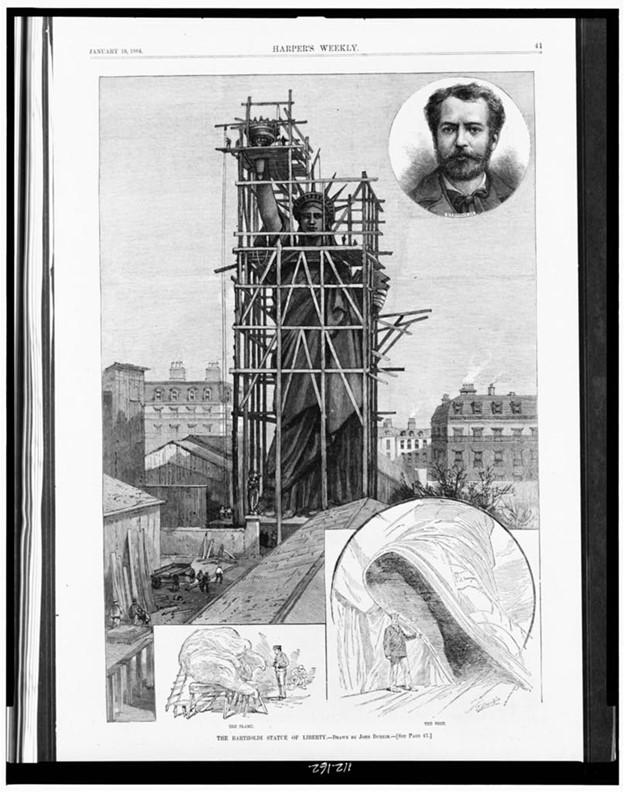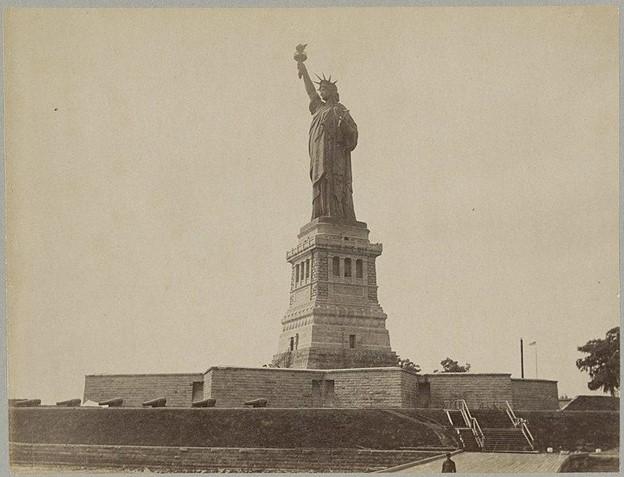The world’s largest online family history resource - Start now
-
Black History Month – Ancestry Initiatives to Honor Black Heritage -
Marking 80 Years Since Auschwitz Liberation: Our Commitment to Holocaust Remembrance -
1921 Census of England & Wales Now Available -
Updated Ancestral Subregions
GET THE LATEST
New posts + monthly newsletter.
GET THE LATEST
New posts + monthly newsletter.
Standing tall in the New York Harbor is Lady Liberty. This well-known landmark is an iconic tourist spot for millions of visitors each year. While you’ve probably heard about the Statue of Liberty National Monument, it’s also interesting to learn how she became a symbol of democracy, freedom, and hope for the American people.
Whether your ancestors date back to the British colonists or fought alongside George Washington in the American Revolution, learning about the Statue of Liberty history is just one way to discover how your family lived during the founding of America and what side of the fight your relatives were on.
A Brief Statue of Liberty History
Great Britain administered the original 13 colonies, while France claimed control of a large section of land from Louisiana up to the Great Lakes and Canada. The lines between the two settlements weren’t clearly defined. In what is known as the Battle of Jumonville Glen, Lieutenant Colonel George Washington and a group of British colonial forces ambushed a French scouting party near Uniontown, Pennsylvania. The conflict escalated tensions between the British and the French in North America, culminating in the start of the French and Indian War.
In 1778, France formed the Treaty of Alliance with the American Colonies to provide provisions, including money, munitions, and troops, during the American Revolution. This assistance would help George Washington and his troops defeat the British forces and gain independence.
To honor America’s centennial year of independence (1876) and diplomatic relations with France, French political figure Edouard de Laboulaye suggested building a statue and presenting it to the United States as a symbol of freedom and democracy. The proposal turned into reality when his friend and sculptor, Frederic Auguste Bartholdi, began working on the design.
On June 17, 1885, the Statue of Liberty was presented to the United States by France to once again congratulate the United States on its victory in the Revolutionary War and as a symbol of the coalition between the two countries.
Statue of Liberty Meaning and Symbolism
The Statue of Liberty’s full name is Liberty Enlightening the World. Liberty comes from Libertas, the Roman Goddess of Freedom, representing freedom from oppression and tyranny. Both the United States and France stood together for freedom.
The Statue of Liberty is one of the first things travelers and immigrants see when entering the United States through New York Harbor. Because the United States is often referred to as the land of opportunity, Lady Liberty became a symbol of hopeThe right foot at the base of the monument is raised to symbolize the United States would always move forward as proponents of freedom and peace and would influence other countries across the globe with these ideologies.
Liberty’s right arm is held high above her head and holds a torch. The forever-lit torch lights the way to freedom and the path of equal opportunities and liberty for all.
The Statue of Liberty is one of the most famous man-made monuments worldwide due to its size and the story behind its construction. It’s a constant reminder that the United States promises to be a place where liberty and opportunity are possible.
Statue of Liberty Facts: Magnifying the Monument

The Architectural Design
The Statue of Liberty height is 151 feet tall from the base to the top of the torch, which is equivalent to a 22-story building. At the time the monument was erected, it was the tallest structure in the United States. Visitors making their ascent to the crown must climb 377 steps to get a bird’s eye view of New York City.
The statue is reinforced with four interior iron columns that serve as the base for the metal framework, which is made of cast iron and steel. This frame of the statue was designed by Gustave Eiffel, who also designed the Eiffel Tower. To prevent breakage, the statue sways approximately 5 inches back and forth with the wind.
Lady Liberty’s arm is an impressive 46 feet long from her body to the end of the torch, and each finger is 8 feet long. Her nose is nearly 5 feet long, and her waist is an expansive 35 feet across. The base of the monument by itself weighs approximately 54 million pounds or 27,000 tons, and the statue contains 31 tons of copper and 125 tons of steel.
The exterior of the statue is covered in 300 sheets of copper. When the statue was first constructed, it had a reddish-brown appearance like a penny, but time has aged the exterior to a green patina. When the statue was restored in 1986, the torch was covered with 24K gold so that it would appear lit.
The Statue of Liberty tablet contains a sonnet written in 1883 by Emma Lazarus called The New Colossus. This poem features the well-known line, “Give me your tired, your poor, your huddled masses yearning to breathe free.” This plaque is also on display at the Statue of Liberty Museum on Liberty Island.
The Statue of Liberty is struck by lightning approximately 600 times per year, which debunks the theory that lightning never strikes the same place twice.
Assembly and Transportation
Because of the size of the monument, it arrived in America by ship on June 17, 1885, in 350 pieces and in 214 crates. The pedestal took almost a year longer to be built, so the statue remained packed up until April 1886. Before traveling to the United States, the head of the monument was on display at the World’s Fair in Paris in June 1878.
New York struggled with obtaining the funds to build the pedestal for the original Statue of Liberty, so the government turned to crowdfunding. Joseph Pulitzer created a paper campaign asking for donations. Children would also bring pennies to school. Americans raised a total of $270,000 to pay for the base.
Features and Elements
There are many significant features to the design of the statue. The crown has 25 windows, which symbolizes the 25 gemstones found on Earth. The crown has seven points that represent the seven seas and the seven continents.
From an aerial view, you may notice the broken shackles at the feet of the statue. They’re unnoticeable from the pedestal. These chains are a symbol of the abolishment of slavery and a movement toward freedom.
The tablet in the left hand of the monument reads July IV, MDCCLXXVI, which is July 4, 1776, or Independence Day. On this day, the United States adopted the Declaration of Independence and announced its separation from Great Britain.
The Statue of Liberty and Ellis Island: Gateways to America
Liberty Island was once known as Bedloe Island. All ships coming into New York Harbor would pass by the Island on their way to the city. As a result, the island was known as the Gateway to America. When designer Bartholdi visited New York prior to building the statue, he suggested this site for the statue.
From 1892 to 1924, Ellis Island was the most popular immigration station in the United States. More than 12 million immigrants were processed through the Ellis Island immigration station, which is just a short distance from Liberty Island.
Ancestry® has a database containing immigration records dating back to any of your ancestors who may have arrived through theEllis Island immigration station. You can search through ship manifests, historical documents, photographs, and national archives to locate family details.
The Statue of Liberty Over the Years: A Journey Through Time

On October 28, 1886, the Statue of Liberty was dedicated by President Grover Cleveland. Several members of the French and American governments were in attendance.
For the first 16 years, the statue operated as a lighthouse to guide ships into New York Harbor. While most lighthouses used kerosene lamps, Lady Liberty was the first to use electricity. It was decommissioned for that purpose in 1902.
Over time, the monument developed holes and weather damage. Four years before the centennial anniversary of the dedication in 1982, the government launched a crowdfunding campaign to help pay for renovations to the statue, including installing a new torch.
Discover Your Heritage with Ancestry
The Statue of Liberty is an iconic beacon of American ideals that is deeply tied to the stories of those who sought refuge on American shores. Your ancestors’ life in the US may have begun with a glimpse of Lady Liberty as they approached Ellis Island. Start a free trial at Ancestry today to explore billions of records, including immigration records and Ellis Island records.
https://www.nps.gov/stli/learn/management/park-statistics.htm
https://www.mnhs.org/fortsnelling/learn/native-americans/ojibwe-people#:~:text=The%20most%20populous%20tribe%20in,Wisconsin%2C%20Michigan%2C%20and%20Ontario.
https://www.history.com/topics/colonial-america/thirteen-colonies
https://www.ushistory.org/us/8a.asp
https://www.battlefields.org/learn/articles/french-and-indian-war-1754-1763-causes-and-outbreak
https://www.lakegeorge.com/history/fort-william-henry-surrender/
https://guides.loc.gov/treaty-of-alliance-with-france#:~:text=Negotiated%20by%20the%20American%20diplomats,of%20any%20future%20peace%20agreement.
https://www.nps.gov/stli/learn/historyculture/edouard-de-laboulaye.htm
https://www.nps.gov/stli/learn/historyculture/frederic-auguste-bartholdi.htm
https://constitutioncenter.org/blog/the-statue-of-liberty-arrives-in-america
https://obamawhitehouse.archives.gov/blog/2015/06/17/day-history-statue-liberty-came-america#:~:text=The%20Statue%20of%20Liberty%2C%20a,to%20support%20the%20same%20ideals.
https://www.britishmuseum.org/collection/term/BIOG59100
https://www.nypl.org/blog/2015/04/07/statue-liberty-pedestal
https://amhistory.si.edu/starspangledbanner/the-lyrics.aspx
https://bensguide.gpo.gov/j-statue-of-liberty#:~:text=Statue%20of%20Liberty%20facts%20and,by%20an%20internal%20iron%20framework.
https://copper.org/consumers/arts/2008/february/Statue_of_Liberty.php
https://www.poetryfoundation.org/poems/46550/the-new-colossus
https://www.thebattery.org/lady-liberty-10-fascinating-facts/
https://www.history.com/this-day-in-history/statue-of-liberty-arrives-in-new-york-harbor
https://www.thirteen.org/wnet/historyofus/web10/features/see_it_now/1880.0011.html#:~:text=Liberty’s%20head%20was%20completed%20in,the%20%22Monument%20of%20Independence.%22
https://www.nps.gov/stli/learn/historyculture/joseph-pulitzer.htm
https://www.nps.gov/stli/learn/historyculture/places_creating_statue.htm
https://www.nps.gov/stli/learn/historyculture/abolition.htm
https://www.history.com/topics/holidays/july-4th
https://www.nps.gov/stli/learn/historyculture/liberty-island-a-chronology.htm
https://www.history.com/this-day-in-history/statue-of-liberty-dedicated
https://www.lighthousefriends.com/light.asp?ID=581
https://www.nps.gov/stli/learn/historyculture/places_restoring.htm
https://www.mountvernon.org/library/digitalhistory/digital-encyclopedia/article/jumonville-glen-skirmish/
Image 1: https://commons.wikimedia.org/wiki/File:(King1893NYC)_pg183_LIBERTY_ENLIGHTENING_THE_WORLD.jpg
Image 2: https://www.loc.gov/item/95501958/
Image 3: https://commons.wikimedia.org/wiki/File:Vrijheidsbeeld_op_Bedloe%27s_Island_(Liberty_Island),_RP-F-2012-96-170.jpg
























